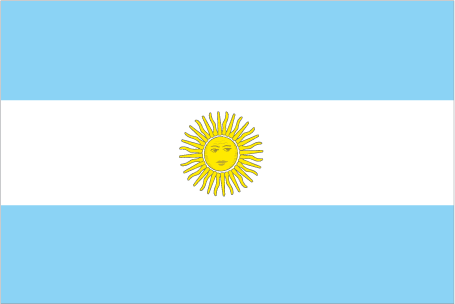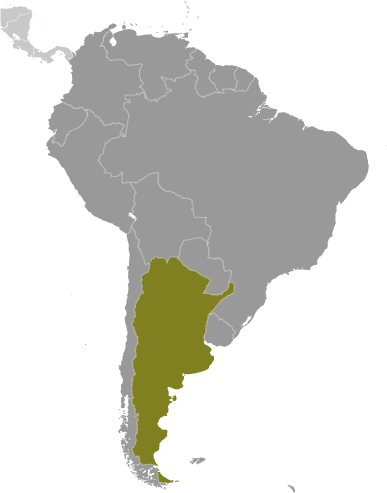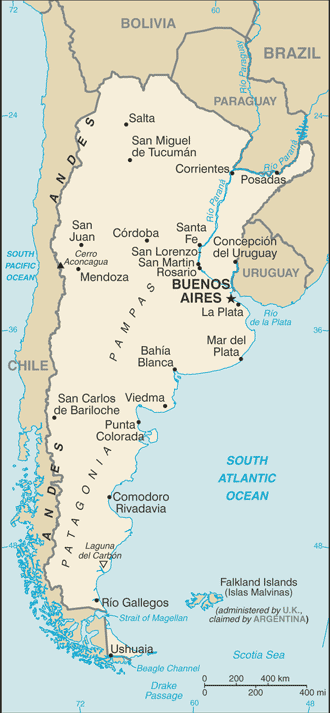|
Country name:
|

|
|
conventional long form: Argentine Republic
conventional short form:
Argentina
local long form:
Republica Argentina
local short form:
Argentina
|
|
|
Government type:
|

|
|
republic
|
|
|
Capital:
|

|
|
name: Buenos Aires
geographic coordinates:
34 35 S, 58 40 W
time difference:
UTC-3 (2 hours ahead of Washington, DC during Standard Time)
daylight saving time:
none scheduled for 2011
|
|
|
Administrative divisions:
|

|
|
23 provinces (provincias, singular - provincia) and 1 autonomous city*; Buenos Aires, Catamarca, Chaco, Chubut, Ciudad Autonoma de Buenos Aires*, Cordoba, Corrientes, Entre Rios, Formosa, Jujuy, La Pampa, La Rioja, Mendoza, Misiones, Neuquen, Rio Negro, Salta, San Juan, San Luis, Santa Cruz, Santa Fe, Santiago del Estero, Tierra del Fuego - Antartida e Islas del Atlantico Sur (Tierra del Fuego), Tucuman
note:
the US does not recognize any claims to Antarctica
|
|
|
Independence:
|

|
|
9 July 1816 (from Spain)
|
|
|
National holiday:
|

|
|
Revolution Day, 25 May (1810)
|
|
|
Constitution:
|

|
|
1 May 1853; amended many times starting in 1860
|
|
|
Legal system:
|

|
|
civil law system based on West European legal systems; note - efforts at civil code reform begun in the mid-1980s has stagnated
|
|
|
International law organization participation:
|

|
|
has not submitted an ICJ jurisdiction declaration; accepts ICCt jurisdiction
|
|
|
Suffrage:
|

|
|
18-70 years of age; universal and compulsory; 16-17 years of age - optional
|
|
|
Executive branch:
|

|
|
chief of state: President Cristina FERNANDEZ DE KIRCHNER (since 10 December 2007); Vice President Amado BOUDOU (since 10 December 2011); note - the president is both the chief of state and head of government
head of government:
President Cristina FERNANDEZ DE KIRCHNER (since 10 December 2007); Vice President Amado BOUDOU (since 10 December 2011)
cabinet:
Cabinet appointed by the president
(For more information visit the World Leaders website  ) )
elections:
president and vice president elected on the same ticket by popular vote for four-year terms (eligible for a second term); election last held on 23 October 2011 (next election to be held in October 2015)
election results:
Cristina FERNANDEZ DE KIRCHNER reelected president; percent of vote - Cristina FERNANDEZ DE KIRCHNER 54%, Hermes BINNER 16.9%, Ricardo ALFONSIN 11.1%, Alberto Rodriguez SAA 8%, Eduardo DUHALDE 5.9%, other 4.1%
|
|
|
Legislative branch:
|

|
|
bicameral National Congress or Congreso Nacional consists of the Senate (72 seats; members are elected by direct vote; presently one-third of the members elected every two years to serve six-year terms) and the Chamber of Deputies (257 seats; members are elected by direct vote; one-half of the members elected every two years to serve four-year terms)
elections:
Senate - last held on 23 October 2011 (next to be held on 27 October 2013); Chamber of Deputies - last held on 23 October 2011 (next to be held on 27 October 2013)
election results:
Senate - percent of vote by bloc or party - NA; seats by bloc or party - FpV 38, UCR 17, PJ Disidente 10, FAP 4, other 3; Chamber of Deputies - percent of vote by bloc or party - NA; seats by bloc or party - FpV 134, UCR 41, PJ Disidente 28, FAP 22, PRO 11, CC 7, other 14; note - as of 1 January 2013, the composition of the entire legislature is as follows: Senate - seats by bloc or party - FpV 32, UCR 14, PJ Disidente 9, minor parties allied with the FpV 6, FAP 4, other 7; Chamber of Deputies - percent of vote by bloc or party - NA; seats by bloc or party - FpV 116, UCR 40, PJ Disidente 22, FAP 22, minor parties allied with the FpV 20, PRO 11, CC 6, other 20
|
|
|
Judicial branch:
|

|
|
Supreme Court or Corte Suprema (the Supreme Court judges are appointed by the president with approval of the Senate)
note:
the Supreme Court has seven judges; the Argentine Congress in 2006 passed a bill to gradually reduce the number of Supreme Court judges to five
|
|
|
Political parties and leaders:
|

|
|
Broad Progressive Front or FAP [Hermes BINNER]; Civic Coalition or CC (a broad coalition loosely affiliated with Elisa CARRIO); Dissident Peronists (PJ Disidente) or Federal Peronism (a sector of the Justicialist Party opposed to the Kirchners); Front for Victory or FpV (a broad coalition, including elements of the PJ, UCR, and numerous provincial parties) [Cristina FERNANDEZ DE KIRCHNER]; Peronist (or Justicialist) Party or PJ [vacant]; Radical Civic Union or UCR [Mario BARLETTA]; Republican Proposal or PRO [Mauricio MACRI]; Socialist Party or PS [Ruben GIUSTINIANI]; numerous provincial parties
|
|
|
Political pressure groups and leaders:
|

|
|
Argentine Association of Pharmaceutical Labs (CILFA); Argentine Industrial Union (manufacturers' association); Argentine Rural Confederation or CRA (small to medium landowners' association); Argentine Rural Society (large landowners' association); Central of Argentine Workers or CTA (a union for employed and unemployed workers); General Confederation of Labor or CGT (Peronist-leaning umbrella labor organization); White and Blue CGT (dissident CGT labor confederation); Roman Catholic Church
other:
business organizations; Peronist-dominated labor movement; Piquetero groups (popular protest organizations that can be either pro or anti-government); students
|
|
|
International organization participation:
|

|
|
AfDB (nonregional member), Australia Group, BCIE, BIS, CAN (associate), CD, CELAC, FAO, FATF, G-15, G-20, G-24, G-77, IADB, IAEA, IBRD, ICAO, ICC (national committees), ICRM, IDA, IFAD, IFC, IFRCS, IHO, ILO, IMF, IMO, IMSO, Interpol, IOC, IOM, IPU, ISO, ITSO, ITU, ITUC (NGOs), LAES, LAIA, Mercosur, MIGA, MINURSO, MINUSTAH, NAM (observer), NSG, OAS, OPANAL, OPCW, Paris Club (associate), PCA, SICA (observer), UN, UNASUR, UNCTAD, UNESCO, UNFICYP, UNHCR, UNIDO, Union Latina (observer), UNTSO, UNWTO, UPU, WCO, WFTU (NGOs), WHO, WIPO, WMO, WTO, ZC
|
|
|
Diplomatic representation in the US:
|

|
|
chief of mission: Ambassador Cecilia NAHON
chancery:
1600 New Hampshire Avenue NW, Washington, DC 20009
telephone:
[1] (202) 238-6400
FAX:
[1] (202) 332-3171
consulate(s) general:
Atlanta, Chicago, Houston, Los Angeles, Miami, New York
|
|
|
Diplomatic representation from the US:
|

|
|
chief of mission: Ambassador Vilma MARTINEZ
embassy:
Avenida Colombia 4300, C1425GMN Buenos Aires
mailing address:
international mail: use embassy street address; APO address: US Embassy Buenos Aires, Unit 4334, APO AA 34034
telephone:
[54] (11) 5777-4533
FAX:
[54] (11) 5777-4240
|
|
|
Flag description:
|

|
|
three equal horizontal bands of light blue (top), white, and light blue; centered in the white band is a radiant yellow sun with a human face known as the Sun of May; the colors represent the clear skies and snow of the Andes; the sun symbol commemorates the appearance of the sun through cloudy skies on 25 May 1810 during the first mass demonstration in favor of independence; the sun features are those of Inti, the Inca god of the sun
|
|
|
National symbol(s):
|

|
|
Sun of May (a sun-with-face symbol)
|
|
|
National anthem:
|

|
|
name: "Himno Nacional Argentino" (Argentine National Anthem)
lyrics/music:
Vicente LOPEZ y PLANES/Jose Blas PARERA
note:
adopted 1813; Vicente LOPEZ was inspired to write the anthem after watching a play about the 1810 May Revolution against Spain
|
|
|
|
|





 )
)



